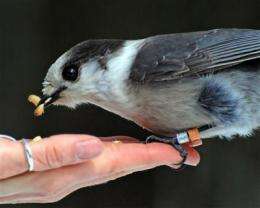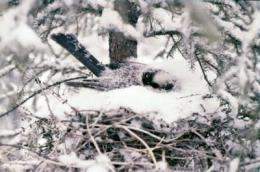Gray jays' winter survival depends on food storage, study shows

A new University of Guelph study shows that gray jays hoping to survive and reproduce through Canada's harsh winters need to be able to store food in the right kinds of trees.
The study appears in Oecologia and was co-authored by Prof. Ryan Norris, Department of Integrative Biology; Brian Kielstra, an undergraduate student in the Department of Geography; and Dan Strickland, retired chief naturalist of Algonquin Park in Ontario.
Unlike most birds that migrate for winter, gray jays are year-round residents in the Canadian boreal forest. In winter, they rely on berries, fungi, insects, carcass meat and other foods cached in nooks and crannies of trees during summer and fall. They remember where they've stored tens of thousands of food items scattered throughout a territory up to 160 hectares in size.
"What is perhaps more remarkable is that female gray jays start breeding in mid-February when temperatures are routinely below minus 15 degrees Celsius and there is very little food around, so these caches are crucial not only for over-winter survival but also for successful reproduction," Norris said.

He and Strickland have studied a population of gray jays on the southern edge of their range in Algonquin Park. Records during the past 33 years show that gray jay numbers have fallen more quickly within territories dominated by deciduous trees, such as sugar maple, than in areas of mostly coniferous trees, particularly black spruce.
The researchers thought that certain tree bark characteristics might influence the quality of food storage sites. The bark and foliage of boreal and subalpine tree species, for example, have antibacterial and antifungal properties that may help preserve food.
To test this idea, they simulated jay caches by attaching small food containers to different trees in the fall. Weighing the food after one to four months, they found that more remained on the spruce and pine than on the deciduous trees.
"The evidence suggests that the resin production of the boreal conifers may be critically important for the survival of gray jays, especially at the southern limits of their range," Norris said. "This fits perfectly with our observation that the jay territories that are no longer occupied in Algonquin Park are the areas dominated by deciduous forest."
An important question still remains: why are gray jays declining in Algonquin Park?
"We think it may have something to do with climate change affecting the quality of cached food, and we are currently conducting a series of experiments to look at this," said Norris.
The Guelph study may help in understanding territorial limits for other boreal breeding animals.
"If other northern-breeding or alpine-breeding species rely on cached food, then their ranges may also be limited by the ability of certain habitat types to preserve food over the winter season."
Provided by University of Guelph

















